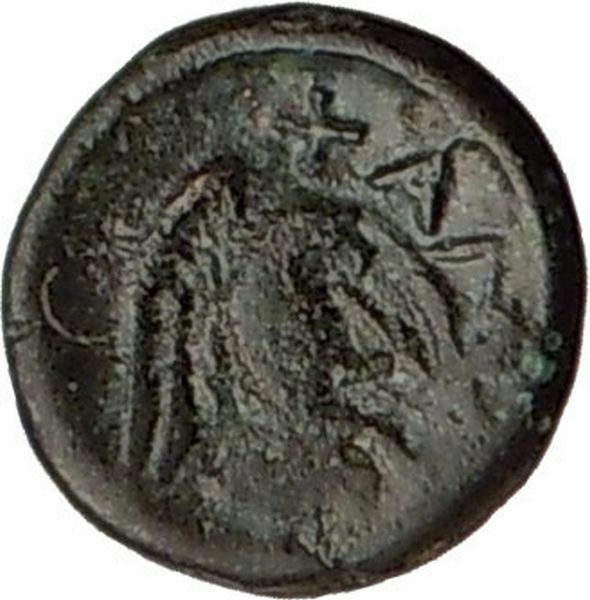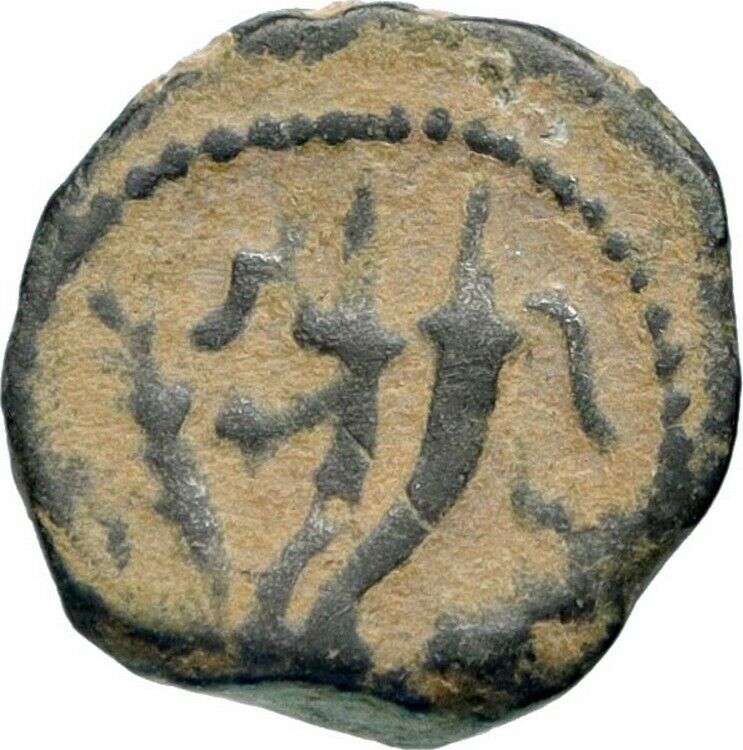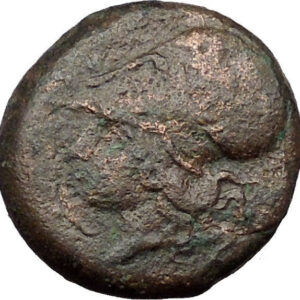|
Greek city of
Korykos in
Cilicia
Bronze 18mm (3.80 grams) Struck 1st Century B.C.
Reference: Imhoof-Blumer, KM 1 var. (Rev. legend); SNG
France 1099 var. (same); BMC -; SNG von Aulock -; SNG
Copenhagen -.
Draped bust of Artemis right, bow and quiver over
shoulder; monogram below chin.
Apollo standing left, holding branch and leaning on
column, KΩΡΥΚΙΩΤΩΝ behind.
A coastal town midway between the
mouths of the rivers Lamos and Kalykadnos, Korykos was
chiefly known for the nearby mountain grotto, called the
Korykian Cave, which was celebrated by the poets.
You
are bidding on the exact item pictured, provided with a
Certificate of Authenticity and Lifetime Guarantee of
Authenticity.
Artemis
was one of
the most widely venerated of the Ancient Greek deities.
Some scholars believe that the name, and indeed the
goddess herself, was originally pre-Greek. Homer refers
to her as Artemis Agrotera,
Potnia Theron
<
Artemis of the wildland, Mistress of Animals”. In the
classical period of
Greek mythology
,
Artemis (Greek:
(nominative)
Ἄρτεμις, (genitive)
Ἀρτέμιδος) was
often
described as the daughter of
Zeus
and
Leto
, and the twin
sister of
Apollo
. She was the
Hellenic goddess of the hunt, wild animals, wilderness,
childbirth, virginity and young girls, bringing and
relieving disease in women; she often was depicted as a
huntress carrying a bow and arrows. The
deer
and the
cypress
were sacred to
her. In later Hellenistic times, she even assumed the
ancient role of
Eileithyia
in aiding
childbirth.
Artemis later became identified with
Selene
, a
Titaness
who was a
Greek moon goddess, sometimes depicted with a crescent
moon above her head. She was also identified with the
Roman goddess
Diana
, with the
Etruscan
goddess
Artume
, and with the
Greek or
Carian
goddess
Hecate

In
Greek
and
Roman mythology
,
Apollo,
is one of the most important and diverse of the
Olympian deities
kouros
(a beardless
youth), Apollo has been variously recognized as a god of
light and the sun; truth and prophecy;
archery
; medicine and
healing; music, poetry, and the arts; and more. Apollo
is the son of
Zeus
and
Leto
, and has a
twin
sister, the chaste
huntress
Artemis
. Apollo is
known in Greek-influenced
Etruscan mythology
as
Apulu. Apollo was worshiped in both
ancient Greek
and
Roman religion
, as well
as in the modern
Greco
–Roman
Neopaganism
.
As the patron of
Delphi
(Pythian
Apollo), Apollo was an
oracular
god — the
prophetic deity of the
Delphic Oracle
.
Medicine and healing were associated with Apollo,
whether through the god himself or mediated through his
son
Asclepius
, yet Apollo
was also seen as a god who could bring ill-health and
deadly
plague
as well as one
who had the ability to cure. Amongst the god’s custodial
charges, Apollo became associated with dominion over
colonists
, and as the
patron defender of herds and flocks. As the leader of
the
Muses
(Apollon
Musagetes) and director of their choir, Apollo
functioned as the patron god of music and
poetry
.
Hermes
created the
lyre
for him, and the
instrument became a common
attribute
of Apollo.
Hymns sung to Apollo were called
paeans
.
In Hellenistic times, especially during the third
century BCE, as Apollo Helios he became
identified among Greeks with
Helios
,
god of the sun
, and his
sister Artemis similarly equated with
Selene
,
goddess of the moon
. In
Latin texts, on the other hand, Joseph Fontenrose
declared himself unable to find any conflation of Apollo
with
Sol
among the
Augustan poets
of the
first century, not even in the conjurations of
Aeneas
and
Latinus
in
Aeneid
XII
(161–215). Apollo and Helios/Sol remained separate
beings in literary and mythological texts until the
third century CE.
Corycus (Greekkk:
Κώρυκος; also
transliterated
Corycos or Korykos;
Armenian
: Կոռիկոս)
was an ancient city in
Cilicia Trachaea
,
Anatolia
, located at the mouth of the Calycadnus
(now
Göksu
); the site is now occupied by the town of
Kızkalesi
(formerly Ghorgos),
Mersin Province
,
Turkey
.
The
city
Strabo
does not mention a town of Corycus, but
reports a promontory so called at the location, but a
town Corycus is mentioned by
Livy
(xxxiii. 20), and by
Pliny
(v. 27), and
Pomponius Mela
(i. 13), and
Stephanus of Byzantium
(s. v. Κώρυκος). In antiquity
Corycus was an important harbor and commercial town. It
was the port of
Seleucia
, where, in 191 BCE, the fleet of
Antiochus the Great
was defeated by the
Romans
. In the Roman times it preserved its ancient
laws; the emperors usually kept a fleet there to watch
over the pirates. Corycus was also a mint in antiquity
and some of its coins survive.
Corycus was controlled by the
Byzantine Empire
.
Justinian I
restored the public baths and a
hospital.
Alexios I Komnenos
re-equipped the fortress, which
had been dismantled. At the beginning of the 12th
century the Byzantines built a supplementary castle on a
small island. This castle was later called “maidens
castle” (Turkish:
Kız kalesi),
because it was told that a king held his daughter here
in captivity until she was killed by a venomous snake.
It was prophesied she would die by a snake bite. So she
was taken to the sea castle to protect her, but a
serpent was taken by basket to the castle, she was
bitten and died. Soon after Corycus was conquered by the
Armenians
, who held it till the middle of the 14th
century, as part of the
Armenian Kingdom of Cilicia
. In the 14th century,
the city was occupied temporarily by the
Turks
, and for a time played an important part. The
city fell to the
Lusignans
of
Cyprus
. It was taken by the
Mamelukes
, and again by
Peter I of Cyprus
in 1361. In the late 14th century
it fell again to the Turks. From 1448 or 1454 it
belonged alternately to the
Karamanlis
, the Egyptians, the Karamanlis a second
time, and finally to the
Osmanlis
.
The ruins of the city are extensive. Among them are a
triumphal arch, a
necropolis
with a beautiful
Christian
tomb,
sarcophagi
, etc. The two medieval castles, one on
the shore, the other in an islet, connected by a ruined
pier, are partially preserved; the former was reputed
impregnable. The walls of the castle on the mainland
contain many pieces of columns; and a mole of great
unhewn rocks projects from one angle of the fortress
about a hundred yards across the bay. Three churches are
also found, one decorated with frescoes. The walls of
the ancient city may still be traced, and there appear
to be sufficient remains to invite a careful examination
of the spot.
The city figures in the
Synecdemus
of
Hierocles
, and about 840 in
Gustav Parthey
‘s Notitia Prima.
Ecclesiastically, it was a
see
, suffragan of
Tarsus
.
Lequien
(II, 879) mentions five
Greek Orthodox
bishops from 381 to 680; another is
known from an inscription (Waddington, Inscriptions
… d’Asie mineure, 341). One
Latin
Bishop, Gerardus, was present at a
Council of Antioch
about 1136; four are known in the
fourteenth century (Lequien,
III, 1197;
Eubel
, I, 218). Corycus remains a
titular see
of the
Roman Catholic Church
, Coryciensis; the seat
is vacant since the death of the last bishop in 1967.
Corycian
Cave
Main article:
Arima, couch of Typhoeus
In the Corycian Cave (now Cennet ve Cehennem), 20
stadia inland, says Strabo, the best
crocus
(saffron)
grows. He describes this cave as a great hollow, of a
circular form, surrounded by a margin of rock, on all
sides of a considerable height; on descending into this
cavity, the ground is found to be uneven and generally
rocky, and it is filled with shrubs, both evergreen and
cultivated; in some parts the saffron is cultivated:
there is also a cave here which contains a large source,
which pours forth a river of pure, pellucid water, but
it immediately sinks into the earth, and flowing
underground enters the sea: they call it the Bitter
Water.
Pomponius Mela
(i.13) has a long description of the
same place apparently from the same authority that
Strabo followed, but more embellished. This place is
probably on the top of the mountain above Corycus.
This place is famed in
Greek mythology
. It is the
Cilician
cave of
Pindar
(Pythian Ode i. 31), and of
Aeschylus
(Prom. Vinct. 350), and as
Arima, couch of Typhoeus
, it is the lair of Zeus’
fiercest opponent, the giant
Typhon
or Typhoeus.
|










